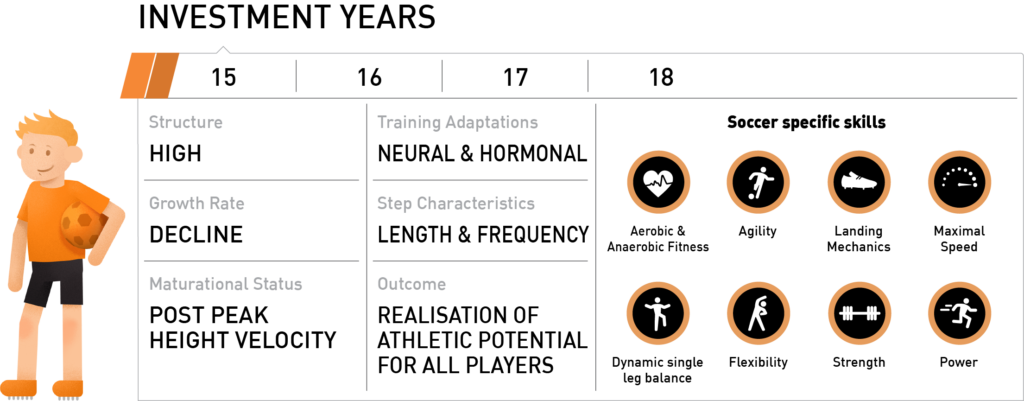In evolutionary terms, human beings simply don’t have the genetic makeup suited for the high octane, fast paced sport that is Soccer. Historically, we developed physiology that would enable us to jog / plod / run slowly for miles upon miles to track down and kill more powerfully built species by fatiguing them, and we were very successful at it! We certainly didn’t develop physical qualities to cope with explosive multi-directional soccer activities such as sprinting, turning, twisting, jumping and kicking. Therefore, given the inherent predisposition of our genetic makeup in evolutionary terms, it would seem that the only way of building soccer specific multiple physical capacities, would be through deliberate practice (Balyi 2014).
Youth soccer players entering the “Investment Years” (between the ages of 15 to 18) are in a favorable period of their lifespan to build soccer specific physical qualities due mainly to high levels of growth hormones circulating around the body (Venturelli et al 2008).

Soccer Specific Physical Qualities
- Technical & Tactical (both on and off the ball)
- Strength (underpins all soccer specific movements)
- Power (jumping, kicking, tackling)
- Speed (acceleration, deceleration, max velocity, change of direction)
- Agility (cognitive ability)
- Aerobic and Anaerobic Capacities (repeated sprint ability)
A foundational value of developing multiple physical qualities is that we can focus on strength, power, aerobic and anaerobic qualities from the very first day of pre-season to ensure that players are optimally conditioned to be able to tolerate the demands of soccer once the competitive season begins.
In this simple activity (see video below) the player is required to accelerate, decelerate, transition between running forwards, sideways and backwards. He also has to change direction, focus on stride frequency (fast feet) through the ladders and hurdles and then on stride length (distance between toe off to touchdown) when finishing off the run on the final aspect of the activity. By manipulating the complexity of the drill, number of repetitions, the length of the drill and the intermittent rest periods we are able to target specific physiological adaptations. For example, if we wish to improve a player’s anaerobic capacity, that is, their ability to carry out repeated sprints during a game, then we could ask the players to run at high intensity in activities which last between 10 to 25 seconds, with rest 40 to 60 seconds rest between each repetition (5 repetitions max). They would then repeat this cycle twice more with a rest period of 3 minutes between each cycle (3 cycles in total). Longer based soccer activities (lasting between 30 to 80 seconds) are excellent for improving aerobic fitness levels (VO2max). The prescription for repetitions and cycles for aerobic training is similar to the anaerobic example given above, however the player will not be able to sustain as high an intensity for running during the activity. Both aerobic and anaerobic activities can be implemented from the start of preseason and can be focused upon simultaneously.
We hope you enjoy this soccer simulated activity. Please feel free to get in contact with us, we would love to hear your thoughts.

 FRA
FRA































